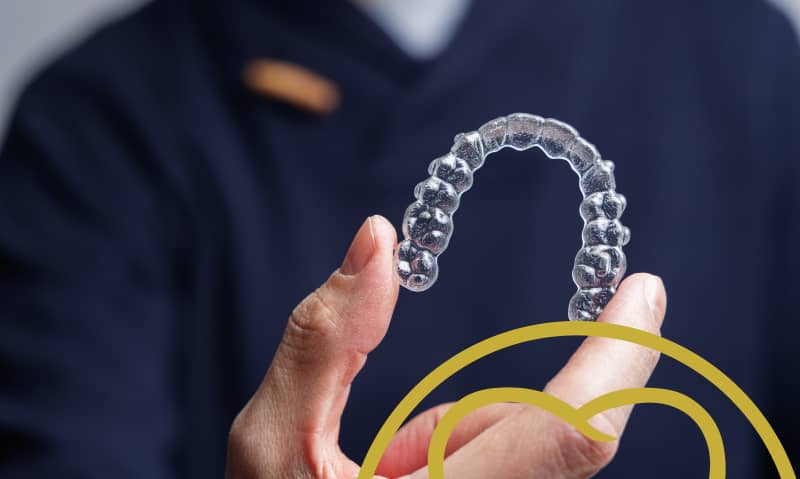Which Is Better: Braces, or Invisalign? 3 Key Points to Consider

Braces or Invisalign: What Is the Right Choice for You?
Traditional braces and Invisalign are both treatment options that can provide excellent results in a wide range of situations. By opting for either treatment, you can enjoy a straight and beautiful smile, along with improved long-term oral health. However, many patients aren’t sure which treatment is right for them.
Consider these three key differences between braces and Invisalign.
1. Invisalign can provide a more comfortable treatment experience.
With both Invisalign and braces capable of delivering results in many of the same situations, much of the difference between the two comes down to treatment experience. Many patients prefer the more flexible treatment experience offered by Invisalign.
Traditional braces use adjustable archwires to guide your teeth into the correct position. The archwires attach to the brackets, which are firmly attached to your teeth with a dental cement. They’re only removed by your orthodontist once treatment is complete.
Invisalign clear aligners are removable at any time. This makes meal times much easier because you simply take the aligners out instead of following any dietary restrictions. The same is true when it comes time to brush your teeth, and you can even remove them for special occasions.
However, that convenience can be a double-edged sword. You need to wear your aligners for at least 22 hours each day to get results from your treatment andit can be incredibly tempting to leave them out for longer periods of time.
Children, in particular, are likely to avoid wearing their aligners in social situations, which can severely impact their treatment. This is why options such as Invisalign Teen feature markings at the back of the aligners that fade when worn, so you can verify that your teen is wearing their aligners.
2. Invisalign is a less conspicuous option than braces.
Invisalign takes its name from the fact that the clear aligners are practically invisible compared to traditional braces. While orthodontic treatment is often associated with children and teens, the less conspicuous appearance is one of the primary reasons Invisalign is leading patients of all ages to seek out orthodontic treatment.
The aligners are transparent, as opposed to the distinct metallic gray of traditional braces. They can even provide a more discreet appearance compared to ceramic braces, which try to approximate the natural color of your teeth. The aligners also follow the contours of your smile instead of extending noticeably beyond it, like braces.
It’s important to note that Invisalign isn’t completely invisible. They’re still noticeable under close inspection, but much less likely to be noticed at a passing glance. You can enjoy a more discreet treatment that has less of an impact on your confidence than traditional braces.
Your Invisalign treatment may also require what Invisalign calls SmartForce attachments. In other clear aligner systems, these are referred to generically as “buttons.”
The buttons are small tooth-colored bumps fixed to the front surfaces of your teeth. They provide improved grip for the aligners, which may be necessary depending on the nature and extent of your treatment plan. Buttons can make your aligners more noticeable and are present even when you take the aligners off.
3. Your individual needs will determine your treatment options.
It’s important to note that whether traditional braces or Invisalign is the best choice for you comes down to your specific needs, rather than one option being better than the other.
Your orthodontist will carefully evaluate your teeth and jaw to determine which treatment options are right for you. The nature and severity of orthodontic issues vary widely, so your individual case is highly unique.
Your orthodontist may determine that both braces and Invisalign are viable treatment options for your case. If so, there are other factors, such as cost, insurance, and your individual preferences, to consider.
However, Invisalign isn’t right for every case. Braces are suitable for treating an extensive range of malocclusion, crowding, and spacing issues. Invisalign can work in most of those cases, but not all. Some are too complex and will require traditional braces to achieve proper results.
Orthodontics include a range of other treatment options and appliances as well. Early orthodontic intervention, in particular, often makes use of other appliances. Your young child may need palatal expanders to correct a narrow palate. Space maintainers are another common treatment used if your child loses a baby tooth prematurely.
These early childhood interventions promote healthy development and can avoid the need for braces or Invisalign treatment later in life. You can help ensure that your child’s developmental needs are met by bringing them in for their first orthodontic evaluation by the age of seven.
Find the right treatment to suit your unique smile.
At Dixon, Boles & Associates, you can find patient-centered, comprehensive dental and orthodontic care for the whole family. With an in-house Wilson, NC, orthodontist, we provide a full range of treatment options, including Invisalign, traditional braces, and more, using the latest technology. Schedule a consultation today to find out which treatment can meet your needs.